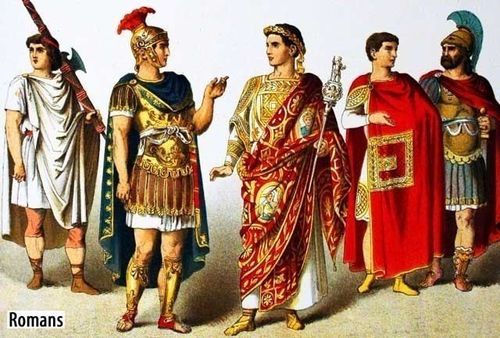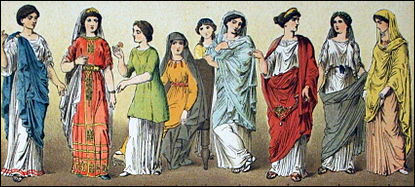The roman clothing was different for every individual. In roman fashion, people were recognized on the basis of their clothing. Toga was worn by the male citizens. People of upper class wore toga made out of linen while the people of lower class wore toga made of thin felt. The tunic was worn by anyone. It was used to wear under the togas which extended till the knees and belted at the waist. Women wore STOLA which had two segments and buttons. STOLA was draped freely. Over that women wore PALLA as a coat.



The men of ancient Rome wore a ring and that was the only jewelry worn by them. In addition to brooches and rings, they also used amulets, talismans, earrings and bracelet which were used by wearer to protect themselves from evil spirits and curses. Men wore bulla, a neck chain and round pouch containing protective amulets before the age of manhood and bulla of upper class families were made of gold. Rings carved with PHALLUS were used for good luck. The women of upper class wore jewelry of bronze and gold. The accessories were decorated and were very expensive. They wore anklets, breast chains, brooches, jeweled buttons, ornamental hairpins etc. women usually dyed with their either golden red color. They tied their hair with jeweled pins. Sometimes they kept their hair open and curled in ringlets. Men had short hair and shaved them. After the time of Hadrian, men began growing beards. Shoes and sandals of different materials were used depending upon the status of the person in the society. They made shoes by fixing strips of leather to tough leather. For summers they had less number of stripes and for winter there were many straps to keep legs warmer inside. Women sandals were called SANDALIUM and the sole was sometimes more thicker to give illusion of height. They also had modern flip flops which were later covered at the toe.
Jewelry


Footwear


Art of ancient Rome
Art of ancient Rome includes architecture, painting, sculpture and mosaic work. Roman art was not just for people of upper class but it included people of middle class. Roman art is mostly borrowed or copied from Greek art. But the Roman art was more innovative. Roman art was more decorative and indicative of status and wealth. Roman art was displayed and owned by people. The people of Rome even did wall art, decorated houses with decorative objects.
Paintings
Wall paintings of ancient times were done using dry method. Roman paintings provide a wide variety of themes animals, still life, lifestyle etc. Erotic scenes in paintings were also common. The landscapes were one with proper perspective. Some were nature paintings while some were architectural. The paintings of still life included things used in daily life. The portraits were realistic painted on glass. The portraits done on coins and medals were considered realistic too. Some paintings include gods and goddesses as well.



Pottery
The art of pottery was not luxury but they were decorated with the latest taste and provided the society with variety of stylish objects at an affordable price. Also, roman coins were in important means of propaganda and have survived in enormous numbers.

Sculpture
Roman sculptures were influenced by the Greek art. Many sculptures were large polychrome terracotta images such as APOLLO OF VEII. Romans were unique with materials. Some of the sculptures of the imperial age were realistic and included ideological messages in the pose. Portrait sculptures were mainly found.


Architecture
Architecture of ancient times of Rome created an architectural style. Factors such as wealth and high population densities in cities forced them to discover and construct more in a more innovative manner. With the help of vaults, knowledge of building materials, they succeeded in making marvelous structures for people to use.


en.wikipedia.org/wiki/Clothing_in_ancient_Rome
www.crystalinks.com/romeclothing.html
en.wikipedia.org/wiki/Roman_art
www.crystalinks.com/romeart.html